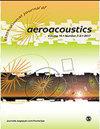针对掠流和高声压级声学衬垫的原位和阻抗衰减实验技术比较
IF 1.3
4区 工程技术
Q3 ACOUSTICS
引用次数: 0
摘要
有几种技术可用于描述声衬垫在掠过流和高声压级(SPL)条件下的特性。虽然原位技术最初是主要的实验程序,但阻抗电导技术在过去几年中也越来越受欢迎。然而,这两种方法之间缺乏比较,尤其是在涡扇发动机的典型工况下。在这项工作中,使用典型的声学衬垫测试样本并考虑到均匀流,对高流速和声压级下的原位和阻抗衰减技术进行了比较。考虑到最近观察到的吸声方法的差异,还将考虑上游和下游的声波传播。提出并验证了一种在原位技术中补偿仪器效应的新方法。结果表明,原位技术和两种诱导技术的体马赫数最高可达 0.5,声压级最高可达 145 dB。这三种方法在没有流动的情况下表现出良好的一致性。在使用诱导技术时,当流动马赫数较高时,会出现意想不到的结果。本文章由计算机程序翻译,如有差异,请以英文原文为准。
A comparison of in situ and impedance eduction experimental techniques for acoustic liners with grazing flow and high sound pressure level
Several techniques are available to characterize acoustic liners when subject to grazing flow and high sound pressure level (SPL). Although the in situ technique started as the primary experimental procedure, impedance eduction techniques have gained popularity over the past years. However, there is a lack of comparison between these group of methods, especially at conditions typically found in turbofan engines. In this work, in situ and impedance eduction techniques are compared at high flow velocities and SPL using typical acoustic liner test samples and considering uniform flow. Both upstream and downstream acoustic wave propagation will also be considered in view of the discrepancies recently observed by eduction methods. A new method to compensate the instrumentation effect in the in situ technique is proposed and validated. Results are obtained for bulk Mach numbers up to 0.5 and SPLs up to 145 dB for both in situ and two eduction techniques. The three methods presents good agreement in the absence of flow. Unexpected results are observed with higher flow Mach numbers using the eduction technique.
求助全文
通过发布文献求助,成功后即可免费获取论文全文。
去求助
来源期刊

International Journal of Aeroacoustics
ACOUSTICS-ENGINEERING, AEROSPACE
CiteScore
2.10
自引率
10.00%
发文量
38
审稿时长
>12 weeks
期刊介绍:
International Journal of Aeroacoustics is a peer-reviewed journal publishing developments in all areas of fundamental and applied aeroacoustics. Fundamental topics include advances in understanding aeroacoustics phenomena; applied topics include all aspects of civil and military aircraft, automobile and high speed train aeroacoustics, and the impact of acoustics on structures. As well as original contributions, state of the art reviews and surveys will be published.
Subtopics include, among others, jet mixing noise; screech tones; broadband shock associated noise and methods for suppression; the near-ground acoustic environment of Short Take-Off and Vertical Landing (STOVL) aircraft; weapons bay aeroacoustics, cavity acoustics, closed-loop feedback control of aeroacoustic phenomena; computational aeroacoustics including high fidelity numerical simulations, and analytical acoustics.
 求助内容:
求助内容: 应助结果提醒方式:
应助结果提醒方式:


